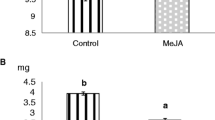Abstract.
As feeding by the tobacco specialist Manduca sexta L. is known to result in significantly higher jasmonate (JA) concentrations in Nicotiana plants than do mechanical simulations of the larval damage, we investigated whether M. sexta, which is known to rapidly consume large quantities of leaf material, can impair this “recognition” response by consuming the leaf tissue before it can respond with amplified JA levels. We report that oral secretions (OS) from M. sexta, but not from the cabbage specialist Pieris rapae, amplified the wound-induced JA response of Nicotiana attenuata Torr. Ex Wats., regardless of larval diet, instar and molting stage, and were still active after boiling and when diluted to 1/1000. The largest JA response occurred within 40 min in tissues adjacent to the OS application site. When 3 mm of leaf tissue immediately adjacent to the OS application site was excised within 40 s, the signal that elicits JA amplification was found to travel rapidly into the leaf, beyond the mandibular reach of the larvae. We conclude that M. sexta is not able to consume the evidence of feeding activity.
Similar content being viewed by others
Author information
Authors and Affiliations
Additional information
Received: 16 July 1999 / Accepted: 12 August 1999
Rights and permissions
About this article
Cite this article
Schittko, U., Preston, C. & Baldwin, I. Eating the evidence? Manduca sexta larvae can not disrupt specific jasmonate induction in Nicotiana attenuata by rapid consumption. Planta 210, 343–346 (2000). https://doi.org/10.1007/PL00008143
Issue Date:
DOI: https://doi.org/10.1007/PL00008143




